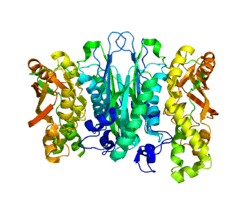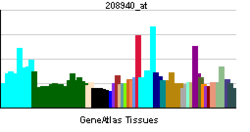Selenophosphate synthetase 1
Selenide, water dikinase 1 is an enzyme that in humans is encoded by the SEPHS1 gene.[3][4]
This protein encodes an enzyme that synthesizes selenophosphate from selenide and ATP. Selenophosphate is the selenium donor used to synthesize selenocysteine, which is co-translationally incorporated into selenoproteins at in-frame UGA codons.[4]
References
Further reading
- Strausberg RL, Feingold EA, Grouse LH, et al. (2003). "Generation and initial analysis of more than 15,000 full-length human and mouse cDNA sequences.". Proc. Natl. Acad. Sci. U.S.A. 99 (26): 16899–903. doi:10.1073/pnas.242603899. PMC 139241
 . PMID 12477932.
. PMID 12477932.
- Gerhard DS, Wagner L, Feingold EA, et al. (2004). "The status, quality, and expansion of the NIH full-length cDNA project: the Mammalian Gene Collection (MGC).". Genome Res. 14 (10B): 2121–7. doi:10.1101/gr.2596504. PMC 528928
 . PMID 15489334.
. PMID 15489334.
- Tamura T, Yamamoto S, Takahata M, et al. (2004). "Selenophosphate synthetase genes from lung adenocarcinoma cells: Sps1 for recycling L-selenocysteine and Sps2 for selenite assimilation.". Proc. Natl. Acad. Sci. U.S.A. 101 (46): 16162–7. doi:10.1073/pnas.0406313101. PMC 528966
 . PMID 15534230.
. PMID 15534230.
- Stelzl U, Worm U, Lalowski M, et al. (2005). "A human protein-protein interaction network: a resource for annotating the proteome.". Cell. 122 (6): 957–68. doi:10.1016/j.cell.2005.08.029. PMID 16169070.
- Rual JF, Venkatesan K, Hao T, et al. (2005). "Towards a proteome-scale map of the human protein-protein interaction network.". Nature. 437 (7062): 1173–8. doi:10.1038/nature04209. PMID 16189514.
- Saiki R, Nagata A, Kainou T, et al. (2005). "Characterization of solanesyl and decaprenyl diphosphate synthases in mice and humans.". FEBS J. 272 (21): 5606–22. doi:10.1111/j.1742-4658.2005.04956.x. PMID 16262699.
- Chung HJ, Yoon SI, Shin SH, et al. (2006). "p53-Mediated enhancement of radiosensitivity by selenophosphate synthetase 1 overexpression.". J. Cell. Physiol. 209 (1): 131–41. doi:10.1002/jcp.20714. PMID 16786570.




 . PMID 12477932.
. PMID 12477932. . PMID 15489334.
. PMID 15489334. . PMID 15534230.
. PMID 15534230.